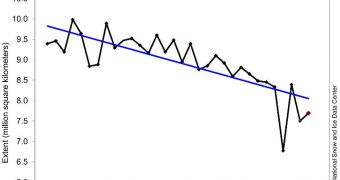Climate experts say that, even if the frosty season began at areas around the North Pole, the extent of Arctic sea ice has not grown as much as it should. Rapid freezing occurred throughout the first half of October, but the amount of ice currently near the Pole is still diminutive compared to other years.
Arctic sea ice reached its lowest extent on September 19, marking the third-lowest spread in recorded history. Hope were high that the ices would extend come October and November, but that doesn't seem to be happening at the expected rate.
It was additionally observed that air temperatures in the region were considerably higher than the usual average, a fact that also hampered the formation of new ice sheets.
Satellite surveys show that the Arctic had 7.69 million square kilometers (2.97 million square miles) of ice this October, which means that this year's level is well below the 1979-2000 baseline.
Researchers say that some 1.60 million square kilometers (618,000 square miles) of ice sheets did not form this year when compared to others.
But investigators also have some good news. This year's ice extent for October was about 920,000 square kilometers larger than the lowest on record, which was measured in October 2007.
“Following the minimum ice extent on September 19, the ice cover quickly expanded as polar darkness returned to the Arctic and air temperatures dropped,” say experts at the National Snow and Ice Data Center (NSIDC).
“Ice grew at an average daily rate for the month of October of 92,700 kilometers per day (35,800 square miles per day). This was similar to the growth rate in 2009, but slower than the growth rate following the 2007 and 2008 minimum ice extents,” they add in a press release.
As far as temperatures go, the investigators said that the air was cooled below the freezing point of water at all times. However, mean temperatures recorded for October showed differences of 4 to 6 degrees Celsius (7 to 10 degrees Fahrenheit) form normal values.
“The warm conditions resulted partly from regions of open water releasing heat to the atmosphere, and in part from an atmospheric circulation pattern that brought warm air from lower latitudes to the Arctic,” the NSIDC group reports.
The Arctic has been deteriorating steadily for the past few decades, and it now barely has any multi-year ice left. This is the ice that does not melt in the summer. Most of the ice sheets now around the North Pole are seasonal, and they disappear during the summer.

 14 DAY TRIAL //
14 DAY TRIAL //